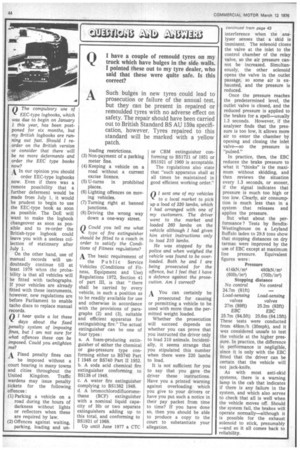Q I sent one of my vehicles to a local market
Page 66

If you've noticed an error in this article please click here to report it so we can fix it.
to pick up a load of 220 lambs, which I had arranged with one of my customers. The driver went to the market and loaded 260 lambs on the vehicle although I had given him strict instructions only to load 210 lambs.
He was stopped by the police and when weighed the vehicle was found to be overloaded. Both he and I are being prosecuted for the offence, but I feel that I have a defence against the prosecution. Am I correct?
A You can certainly be prosecuted for causing or permitting a vehicle to be used with more than the permitted weight loaded.
Whether the prosecution will succeed depends on whether you can prove that you instructed the driver only to load 210 animals. Incidentally, it seems strange that you stipulated this number when there were 220 lambs to load.
It is not sufficient for you to say that you gave the driver these instructions. Have you a printed warning against overloading which you give to your drivers or have you put such a notice in their pay packet from time to time? If you have done so, then you should be able to produce a copy to the court to substantiate your allegation. interference when the analyser senses that a skid is imminent. The solenoid closes the valve at the inlet to the control chamber of the relay valve, so the air pressure cannot be increased. Simultaneously, the other solenoid opens the valve in the outlet passage, so some air is exhausted, and the pressure is reduced.
Once the pressure reaches the predetermined level, the outlet valve is closed, and the reduced pressure is applied to the brakes for a spell—usually 1.3 seconds. However, if the analyser finds that the pressure is too low, it allows more air to enter the chamber by opening and closing the inlet valve—so the pressure is "pulsed."
In practice, then, the EBC reduces the brake pressure to what it "thinks" is the maximum without skidding, and then reviews the situation every 1.3 seconds, or sooner, if the signal indicates that pressure is much too high or too low. Clearly, air consumption is much less than in a system that releases and applies the pressure.
But what about the performance? Tests by BendixWestinghouse on a Leyland Buffalo laden to 29.8 tons show that stopping distances on dry tarmac were improved by the use of EBC except at maximum line pressure. Equivalent figures were: Pressure 414kN/m2 480kN/m2 (601b/in2) (701b/in2) Stopping distance No control No control 24.7m (81ft) Load-sensing Load-sensing valves valves 27m (89ft) 25.2m (83ft) EBC EBC 25.7m (84.5ft) 25.6m (84.15ft) These tests were conducted from 48km/h (30mph), and it was considered unsafe to test the vehicle at the higher pressure. In practice, the difference in performance is negligible, since it is only with the EBC fitted that the driver can be certain that the vehicle will not jack-knife.
As with most anti-skid systems, there is a warning lamp in the cab that indicates if there is any failure in the system, and which also serves to check that all is well when the vehicle moves off. Should the system fail, the brakes will operate normally—although it is possible for the exhaust solenoid to stick, presumably —and so it all comes back to reliability.
















































































































